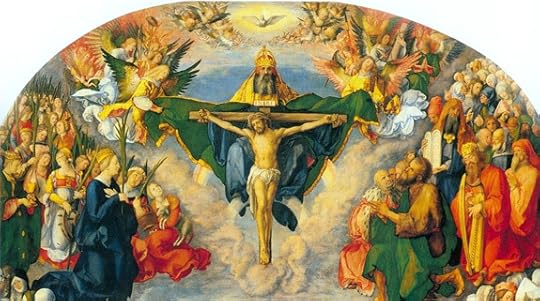Souls, Saints, and the "Permanent Things"

All Saints picture ("Allerheiligenbild") by Albrecht Durer (1511)
Souls, Saints, and the "Permanent Things" | Fr. James V. Schall, S.J. | CWR
We are in danger of losing contact with the dead in our families and in our culture
I.
A seminary in Ireland,
now closed, was dedicated to the training of priests for foreign missions, for
strange places such as California. It was called "All Hallows", that is, All
Saints, November 1. Oxford University in England has a college called "All
Souls," November 2. Taken together, all saints and all souls are designed to
cover all of the final combinations of the human race except all the still
living, who are waiting to join one or the other of the previous categories.
Come to think of it, all "all saints" all have souls. What are left are all
lost souls who, presumably, have already also made their final choices about
how they are permanently to be.
Most of my relatives are buried in the Catholic Cemetery
just at the edge of Pocahontas, a small county seat in rural northwest Iowa. My
mother's grandparents, my grandparents on both sides of my family, my mother
herself, and, I believe, all but one of her thirteen brothers and sisters are
buried in this neat cemetery. Two of my father's brothers are also there; his
other brother is a few miles east in the cemetery in Clare. Two of my father's
four sisters are buried there, as well as numerous cousins and their families,
though many are scattered in later years. My own father is buried in the
cemetery in Santa Clara, and my brother in the cemetery in Spokane.
On the Second of November, many families, especially in small
towns, decorate the graves with flowers, have Masses or prayers said for their
deceased relatives, and in general remember them. In modern cities, I think, we
are in danger of losing contact with the dead in our families and in our
culture. Families move. Cremation changes things. There are so many of us. We
do not have to be superstitious, of course. We believe in the immortality of
the soul and the resurrection of the body. Our contact with cemeteries is
designed to recall our very mortality, but also to remind us of what we hold
about death and its place in our lives.
As we get older, we find that many
more of our immediate family are dead than alive. We find friends gone. Such is
our lot. To wish it otherwise, while not a totally unhealthy exercise, needs to
be understood clearly. It is given unto every man once to die, thence the
judgment, as it says in the Book of Maccabees. Death has become a hospital, not
a home, thing. The dead body is a source of parts, to be somehow passed on to
others. We think almost exclusively of the living, not of the dead.
We celebrate lives at funerals. We
do not worry about souls and their fates. The elderly are a problem, even a
social and political problem, not sources of wisdom. Cemeteries are often
desired for the land they take up. Laws exist about how long cemeteries are to
be kept intact. We still notice that many Latino and Asian families somehow
take care of their own elderly at home, whereas with others this care is often
passed on to various institutions and specialists. This may not be all bad, but
we should reflect on it.
II.
Belloc's wonderful book, The
Four Men, describes a walk he took in the
English county of Sussex, from October 29 till All Souls' Day, 1902. As the
four walkers reach the end of their walk, the old man, who, like the other
three walkers, is Belloc himself, makes the following memorable farewell
reflection:
Carl E. Olson's Blog
- Carl E. Olson's profile
- 20 followers



